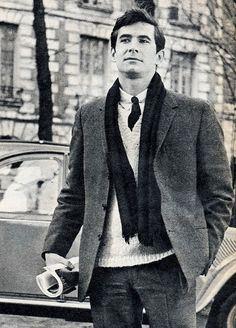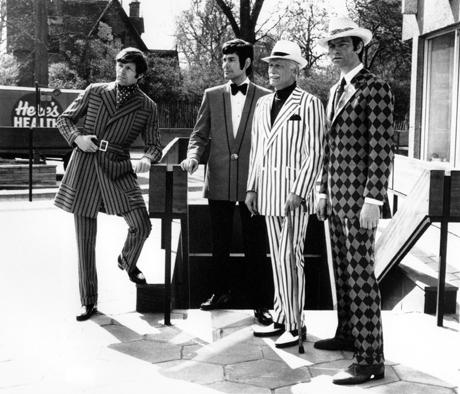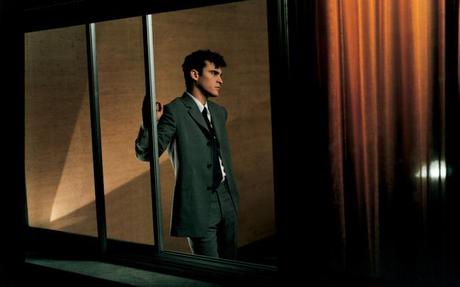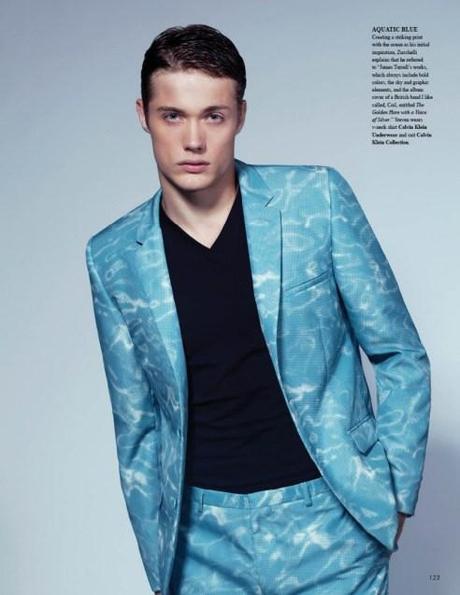The suit is the outfit that is most associated with masculinity and manhood. A symbol of power and elegance, suits have been around for centuries and have evolved and developed as cultures and times changed.
If the first part of the 20th century has seen a big, yet restricted development of the suit, the second part brought the suit in the mainstream and adapted it to the average man’s needs and lifestyle. Suits were no longer reserved for the rich and powerful, but they were a symbol of these two elements. The beginning of the 21st century marked a new beginning for the suit as well, as due to the growth of interest taken by men in fashion, this mark of a reserved elite became an accessible, everyday outfit.
But let’s start with the 60s…
1960s
The 1960s were the time when Western society started to be divided into two major groups. On the one hand, you had the conservative members of society and on the other hand, there were the rebels. Unlike the rebels of the 1950s, who still enjoyed a classic suit, the rebels of the 1960s expressed their opposition to the mainstream norms of society through their looks. The result was the opposite look of what had been mainstream so far: the classic suit was replaced by strongly feminized clothes, bright colors matched to bold accessories and long hair.

Actor Anthony Perkins in the 1960s
But the classic suit was not off the radar: Sean Connery, Michael Caine and even the Beatles were some of the most influential figures of the Western world during the 1960s. Influencers like the Beatles wore skinny-fit suits, collarless jackets and drainpipe trousers that were cut short at the ankles.
The 1960s saw the rebirth of Savile Row as well. Among the new trends, you could see polo-neck sweaters worn with a suit. Savile Row coined the term “bespoke” which came to mean a suit cut by hand and made to fit the wearer.
1970s
The 1970s was the decade of bright colors and flairs. The hippe and boogy-woogy ideology was also reflected in the styles of the era. The disco ideologies were emanated through the suits created by designers in this era, who unleashed their creativity and wanted to create a brand new style. While most designs can’t be seen as classics, they have their importance as they stand as proof of the various fashion experiments that happened through the decade. We wish to believe that only what was the best survived.

New revolutionary Cremplene fashions for men, reminiscent of the Regency days, are shown in London, England on April 17, 1970. From left, a leisure outfit of belted casual coat in triple stripes of clear blue on navy, worn with matching trousers; an evening suit in cord edged jacket in hunting red, with black trousers; a resort suit with double-breasted jacket and bold French navy stripes on white; and a country suit in fern and apple-green diamond pattern with black. (AP Photo/PA)
Tight pants with high waists and big collars were all the staples of the 1970s suits. Wearing hats decreased in popularity and different niches appeared. These would develop their own interpretations of the suit and put their interpretation on this classic piece.
1980s

Robert Downey Jr. and Andrew McCarthy in Less than Zero
The 1980s were in some ways a new beginning for the men’s suit. The looks of this decade were influenced by the pop stars, movie actors, hairy metal bands, androgynous singers and TV celebs. An era of opulence, the 1980s were all about showing off your social affiliations and cultural interests. The opulence was very visible in all the facets of style, as suits became loose and big and were well matched to big haircuts and highly saturated colors.
The different interpretations of the suit, given by the different social and cultural niches, marched along with the more conservative styles of the mainstream. The electric dreams of the 80s were expressed through padded jackets which later became less padded, along with skinny, informal ties and narrow lapels. Pinstripe suits were back in style and the most common looks were two-piece suits rather than three-piece suits. Comfort was the thing used by designers to bring the community together, making suits accessible to everyone who wanted to dress up sharp, but who were afraid that this would mean they had to give up on comfort.
1990s
The urban styles of the 1980s developed into a new style that eventually was to become iconic.
Taking this “relaxed look” to an extreme, the 1990s were full of baggy suits, drab colors, and quite honestly, boring cuts. The focuses of the 1990s: renewing your home, minimalizing technology, searching for better education rather than street fun led to a generation of dark suits and inconsequent shapes.

Actor Joaquin Phoenix for the Prada Men Spring-Summer 1997 campaign
Of course, the suits of the 1990s were not bad fashions because the people were indolent; they were a reflection of the culture that created them. The early years of the decade marked big changes in the world, as the Eastern culture opened up more and more and more to the Western world, the International community was rebuilding and everything was under construction: relations between nations, cities, new technologies. The overall aesthetic of the 1990s does not focus so much on an aesthetic experience as it focuses on practicality and fast innovation. You can find these tendencies in the music scene as well, where (in pop music at least), brief messages were delivered fast and without many metaphors.
The 1990s were very much a time of insecurity and hidden presences in public spaces.
2000s
The 2000s moved the arts to the suburbs and to people’s homes. Private spaces became open to the public and this was a concept that reflected in fashion as well.
Open styles, clean, pastel colors and a “coming out” attitude were what characterized the aesthetics of the 2000s. Of course, the placing of the private in the public world was a reflection of the growing number of “sharing” mediums available on the Internet.
The 2000s were in many fields a time that expressed the need of something new.

From the Fall – Winter 2008 Rugby Ralph Lauren campaign. The 2000s were a time when designer started mixing the classic suit with sporty pieces
Generally, this decade is called the mash-up decade, as it mixed influences and ideas. Shrunken suits became “the look”, but generally suits were out of style during this decade. In the 2000s, suits were simply seen as a “formal look” and were worn only when required (with exceptions, of course). The reason behind this trend was that people wanted to live in new ways and the first thing one does when he wants to live in a new way and doesn’t know how to, is to throw the old out. And that’s fair in the end.
For a better understanding of this mentality, we can look again at popular music. We always say that fashion and music connect greatly and that they can strongly influence each other. If you look at the music videos of the 2000s compared with those of the 1990s, you can see that they are shot in either houses or in public spaces, compared to those from the 90s which were shot mostly in unclear spaces. In the 2000s, you can clearly see faces in daylight rather than shadows in private spaces, as you can see in the 1990s.
The 2000s were a time when very much changed very rapidly and this is why it is hard to speak about a “main” style.
2010 – 2014
In the beginning of the teens, which are currently still ongoing, designers and their audience discovered that there is no need to throw the old out in order to create something new. The revival of men’s style was built on the classic pieces of the past decades, especially on the styles of the 20s 40s and 50s, but with a modern interpretation of these. Vintage and vintage-inspired pieces are the staples of the early 2010s.
The world opened up again, as events such as the Arab spring unfolded, but unlike in the 90s, when the world had opened up to the post-communist world, this time the Western world was more used to other cultures and other visions.
In pure post-modern spirit, the suits of the early teens are in most cases, references: they always reference a place, a person, a time or an event. Originality is gold. Our world is building gradually entering into a new stage, where everyone realizes that we are all connected and the organic technology we use is what connects us. We don’t need to ‘be’ in a certain place have a certain look. For the man of the 2010s, technology is no longer a separate thing; it is integrated in his lifestyle and defines his personality.

From the Calvin Klein 2014 Resort collection
With all these references around, today style becomes more preeminent rather than fashion. It is important to observe that currently niches are the new mainstream. The new mainstream is basically composed of many, various visions, concepts, aesthetics and styles. Today we know that fashion does not mean discomfort and therefore, the suit is no longer something to be worn only in reserved settings and we know that each man can create his own style from the various fashions that emerge.
To detail all the trends in men’s suits that existed throughout the second half of the 20th century would take up a lot more space than this piece allows. Each variation of the suit had a thought behind them (which at the time was coherent and logic). As you can see, with every decade, fashion became more a conceptual thing than a functional – cultural thing. In the end, whether we want to admit it or not, our clothes say more about us than we actually think. They reflect concepts, paradigms, world views and personal characteristics.
So, what suit are you wearing?
Fraquoh and Franchomme
P.S. Which styles do you like best? Is it the colorful, hippie look of the 1970s or the saggy styles of the 1980s and 90s? Share your thoughts, questions or feedback on the article in the comments below! For more style advice and fashion tips and cultural insights, you can subscribe to Attire Club via e-mail or follow us on Facebook or Twitter!
Share on Tumblr0–
